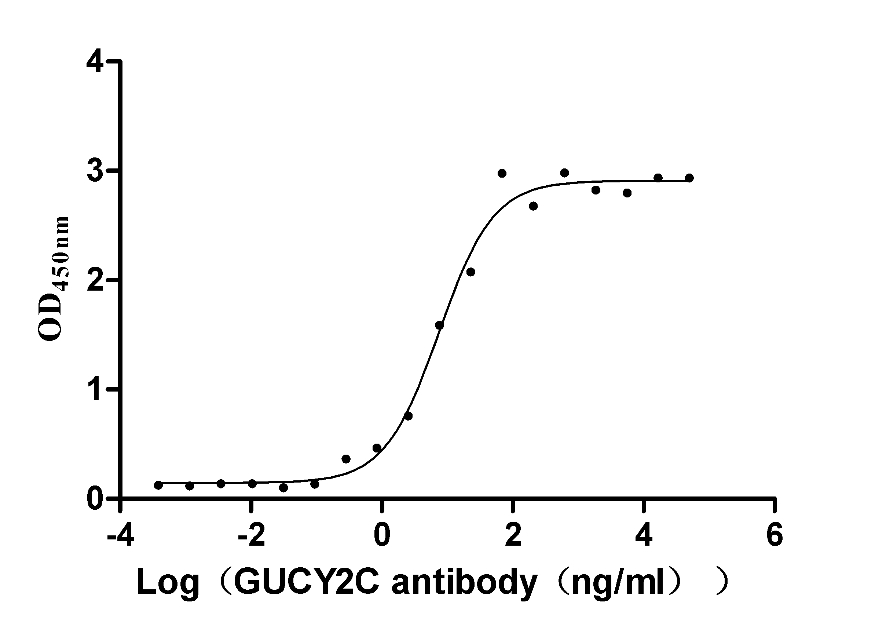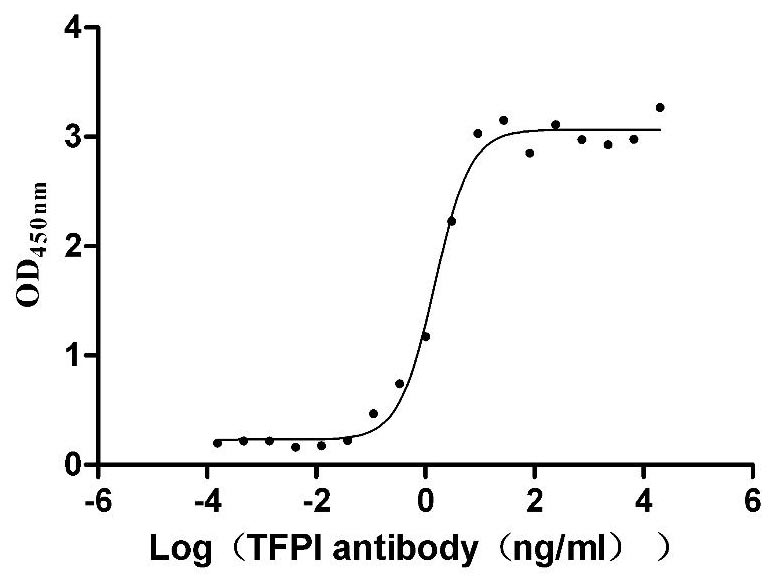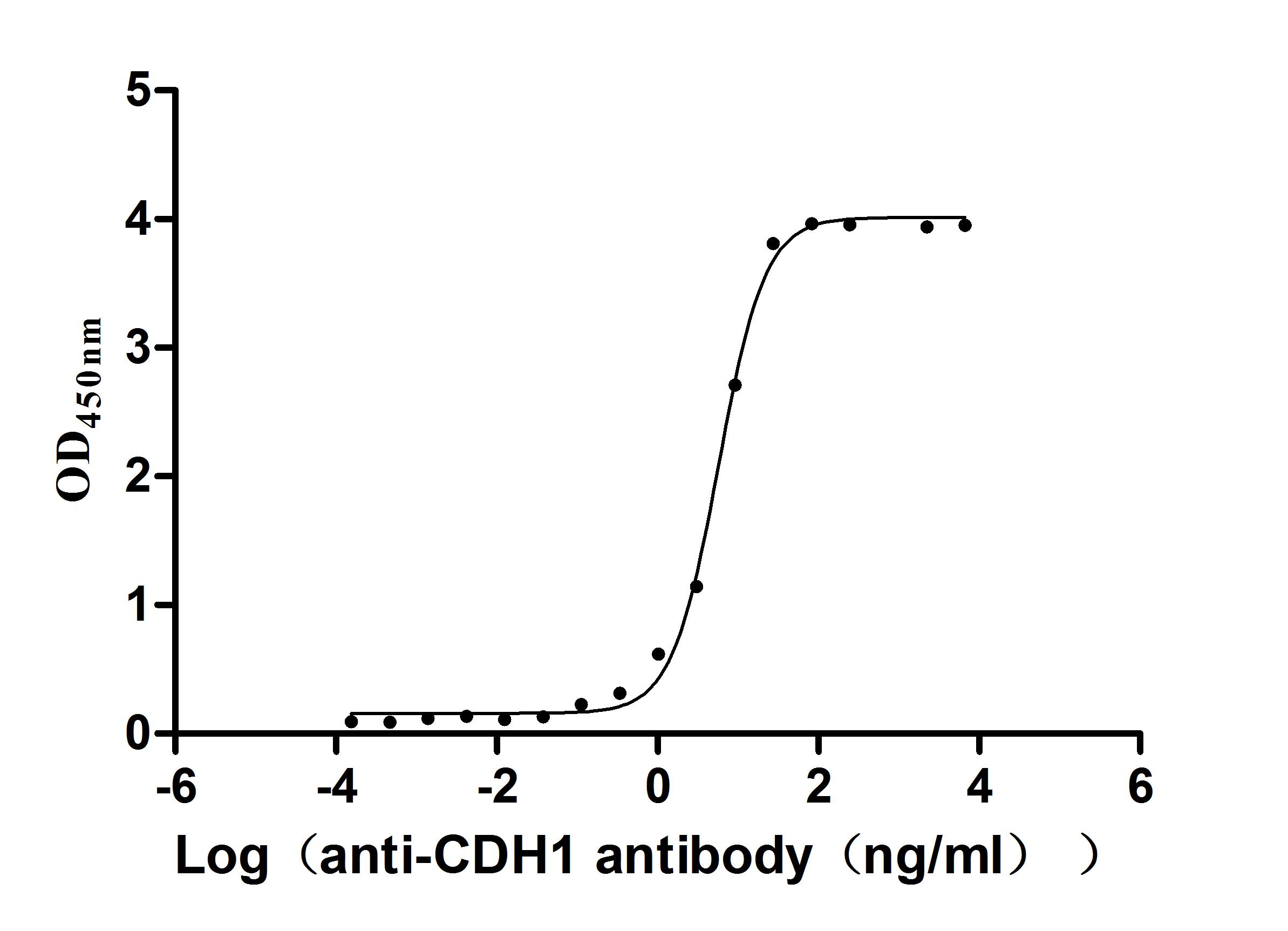Recombinant Escherichia coli Trigger factor (tig)
-
货号:CSB-YP359078ENV
-
规格:
-
来源:Yeast
-
其他:
-
货号:CSB-EP359078ENV
-
规格:
-
来源:E.coli
-
其他:
-
货号:CSB-EP359078ENV-B
-
规格:
-
来源:E.coli
-
共轭:Avi-tag Biotinylated
E. coli biotin ligase (BirA) is highly specific in covalently attaching biotin to the 15 amino acid AviTag peptide. This recombinant protein was biotinylated in vivo by AviTag-BirA technology, which method is BriA catalyzes amide linkage between the biotin and the specific lysine of the AviTag.
-
其他:
-
货号:CSB-BP359078ENV
-
规格:
-
来源:Baculovirus
-
其他:
-
货号:CSB-MP359078ENV
-
规格:
-
来源:Mammalian cell
-
其他:
产品详情
-
纯度:>85% (SDS-PAGE)
-
基因名:tig
-
Uniprot No.:
-
别名:tig; b0436; JW0426; Trigger factor; TF; EC 5.2.1.8; PPIase
-
种属:Escherichia coli (strain K12)
-
蛋白长度:full length protein
-
表达区域:1-432
-
氨基酸序列MQVSVETTQG LGRRVTITIA ADSIETAVKS ELVNVAKKVR IDGFRKGKVP MNIVAQRYGA SVRQDVLGDL MSRNFIDAII KEKINPAGAP TYVPGEYKLG EDFTYSVEFE VYPEVELQGL EAIEVEKPIV EVTDADVDGM LDTLRKQQAT WKEKDGAVEA EDRVTIDFTG SVDGEEFEGG KASDFVLAMG QGRMIPGFED GIKGHKAGEE FTIDVTFPEE YHAENLKGKA AKFAINLKKV EERELPELTA EFIKRFGVED GSVEGLRAEV RKNMERELKS AIRNRVKSQA IEGLVKANDI DVPAALIDSE IDVLRRQAAQ RFGGNEKQAL ELPRELFEEQ AKRRVVVGLL LGEVIRTNEL KADEERVKGL IEEMASAYED PKEVIEFYSK NKELMDNMRN VALEEQAVEA VLAKAKVTEK ETTFNELMNQ QA
-
蛋白标签:Tag type will be determined during the manufacturing process.
The tag type will be determined during production process. If you have specified tag type, please tell us and we will develop the specified tag preferentially. -
产品提供形式:Lyophilized powder
Note: We will preferentially ship the format that we have in stock, however, if you have any special requirement for the format, please remark your requirement when placing the order, we will prepare according to your demand. -
复溶:We recommend that this vial be briefly centrifuged prior to opening to bring the contents to the bottom. Please reconstitute protein in deionized sterile water to a concentration of 0.1-1.0 mg/mL.We recommend to add 5-50% of glycerol (final concentration) and aliquot for long-term storage at -20℃/-80℃. Our default final concentration of glycerol is 50%. Customers could use it as reference.
-
储存条件:Store at -20°C/-80°C upon receipt, aliquoting is necessary for mutiple use. Avoid repeated freeze-thaw cycles.
-
保质期:The shelf life is related to many factors, storage state, buffer ingredients, storage temperature and the stability of the protein itself.
Generally, the shelf life of liquid form is 6 months at -20°C/-80°C. The shelf life of lyophilized form is 12 months at -20°C/-80°C. -
货期:Delivery time may differ from different purchasing way or location, please kindly consult your local distributors for specific delivery time.Note: All of our proteins are default shipped with normal blue ice packs, if you request to ship with dry ice, please communicate with us in advance and extra fees will be charged.
-
注意事项:Repeated freezing and thawing is not recommended. Store working aliquots at 4°C for up to one week.
-
Datasheet :Please contact us to get it.
靶点详情
-
功能:Involved in protein export. Acts as a chaperone by maintaining the newly synthesized secretory and non-secretory proteins in an open conformation. Binds to 3 regions of unfolded substrate PhoA, preferring aromatic and hydrophobic residues, keeping it stretched out and unable to form aggregates. Binds to nascent polypeptide chains via ribosomal protein L23. Functions as a peptidyl-prolyl cis-trans isomerase in vitro, this activity is dispensible in vivo for chaperone activity.
-
基因功能参考文献:
- by combining the transcriptome and phenotype results, a physiological mechanism underlying the impact of TF deletion on the transcriptome profile was proposed. PMID: 27279076
- The structures reveal distinct degrees of flexibility for the different trigger factor domains, a conformational rearrangement of the N-terminal ribosome-binding domain upon ribosome binding, and an increase in rigidity within trigger factor when the nascent peptide chain is extended. PMID: 27320387
- Trigger factor prevents signal recognition particle binding to the majority of ribosomes, except those presenting SRP-specific signal sequences. PMID: 24939037
- Fused the ANTXR2 ectodomain to the C-terminus of bacterial Trigger Factor (TF), and the fusion protein was overly expressed as a dominant soluble protein in E coli. PMID: 24380801
- ribosome- and Trigger Factor-specific activities together constitute an efficient mechanism to prevent or even revert premature folding, effectively limiting misfolded intermediates during protein synthesis PMID: 22921937
- Studies of the Escherichia coli chaperone trigger factor (TF) reveal that, though TF can interact with many polypeptides, beta-barrel outer-membrane proteins are the most prominent substrates PMID: 22153074
- mutant TF lacking the PPIase domain is more efficient than wild-type TF in enhancing the folding yield of multi-domain proteins such as firefly luciferase PMID: 20659464
- contact with trigger factor with Tat protein was strictly dependent on the context of the translating ribosome, started early in biogenesis when the nascent chain left the ribosome near L23, and persisted until the chain reached its full length PMID: 15606765
- structural integrity of the C-terminus contributes to both the chaperone function of TF and the stability of the dimeric form PMID: 16380200
- Supports productive de novo folding by shielding nascent polypeptides on the ribosome thereby preventing untimely degradation or aggregation processes. PMID: 16407311
- the molecular environment of a signal sequence at the ribosome depends on downstream sequence elements that can cause an alternate recruitment of signal recognition particle and the ribosome-associated chaperone Trigger factor to a growing nascent chain PMID: 16421097
- the SRP appears perfectly capable of distinguishing SA sequences from signal sequences in secretory proteins at an early stage in biogenesis PMID: 16551615
- Escherichia coli trigger factor C-terminal domain represents the central module of its chaperone activity PMID: 16926148
- there are two regions on TF along which nascent chains can interact, the NC-domains as the main site and the PPIase domain as an auxiliary site PMID: 17296610
- Sequence of molecular interactions of Escherichia coli TF and nascent chains during translation was identified. PMID: 18497744
- Trigger factor (TF) might be important in responding to stress damage, such as heat shock. PMID: 18539163
- Ribosome-free TF stably associates with and rescues from misfolding a large repertoire of full-length proteins; study identifies over 170 members of this cytosolic Escherichia coli TF substrate proteome, including ribosomal protein S7. PMID: 19737520
收起更多
-
亚细胞定位:Cytoplasm.
-
蛋白家族:FKBP-type PPIase family, Tig subfamily
-
数据库链接:
KEGG: ecj:JW0426
STRING: 316385.ECDH10B_0392




















